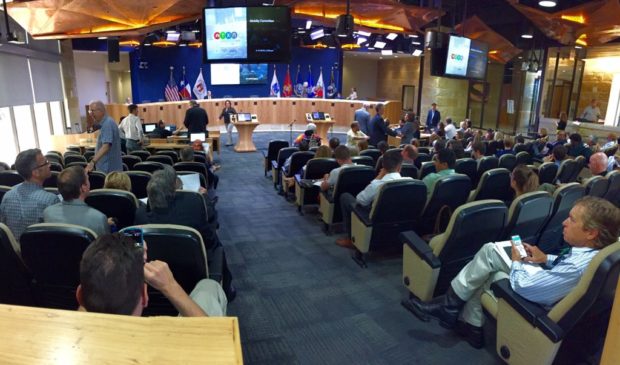Mobility Committee balks at Adler’s bond recommendation
Wednesday, June 15, 2016 by
Caleb Pritchard In the race among the growing list of proposals for a November bond referendum, City Council’s Mobility Committee jockeyed into the lead on Tuesday evening a dark-horse recommendation.
With a vote of 4-0, the committee endorsed Council Member Ann Kitchen’s $300 million proposal, which she unveiled to little fanfare on Council’s online bulletin board on Monday. It would fund a grab-bag of highway and arterial projects as well as provide tens of millions in sidewalk and bicycle infrastructure investments.
Kitchen’s nine-figure plan pencils out to less than half of the $720 million proposal Mayor Steve Adler floated last month that was backed by business groups such as the Austin Chamber of Commerce. On Tuesday morning, Council members Greg Casar and Leslie Pool offered an amended version of Adler’s proposal that removed regional highway spending in favor of much more generous spending on bicycle, sidewalk and transit projects.
“From my perspective, this is a starting point for discussion,” Kitchen said of her proposal to her colleagues on the dais, which included not only the three members of the Mobility Committee but also every other Council member except Mayor Pro Tem Kathie Tovo.
Kitchen, who chairs the committee, explained that her interest in a more modest plan is rooted in anticipation of a more comprehensive bond referendum in 2018. She also suggested that Council should wait for the results of two significant and ongoing transportation planning efforts: the city’s nascent Strategic Mobility Plan and Capital Metro’s next five-year service plan known as Connections 2025.
The vote on the recommendation was preceded by a lengthy public hearing in which more than two dozen speakers held forth on a variety of preferences for mobility investments. One after another, they peppered Council members with requests to consider better transit options, new sidewalks, safer bicycle lanes, improved accessibility and stronger considerations for safety, among other topics.
Scott Morris of the Central Austin Community Development Corporation (CACDC), the nonprofit that is championing a light rail starter route on Guadalupe Street and N. Lamar Boulevard, told Council members, “In this year of mobility, we need public transit, a proven mobility alternative on the ballot. We feel the people of Austin are ready to take that step. Voters deserve that choice in November.”
After several other speakers also endorsed light rail, Council Member Delia Garza asked a representative of Capital Metro if the transit agency is prepared for a light rail bond this year.
“That’s a challenging question to answer,” replied Todd Hemingson, vice president of Strategic Planning and Development at Capital Metro.
He explained that putting together a rail proposal is a “deliberative process,” one that he suggested will be explored by the Project Connect Central Core Study, which is set to begin in earnest this fall. Earlier in the meeting, Hemingson said that effort is expected to deliver a “fundable set of priority projects” by November 2018.
In addition to Hemingson, the committee also heard from Russ Chisholm of Transit Management and Design, the consultant working with Capital Metro to develop the Connections 2025 service plan. During the discussion on the dais, Adler spoke of Chisholm’s outside expertise.
“I think that the citizens and residents of our city want us to actually do something about congestion in this city and traffic and with respect to improving transit service in the city,” Adler said before asking, “Generally speaking, can you tell us anything about what level of investment as a community we should be making?”
“I would say you need to go big,” Chisholm replied, echoing language that Adler himself has used in the context of the proposed mobility bond. “The bigger investments will bring the economic benefits. They’ll bring the intensification. They’ll bring all those good things that help the neighborhood and community quality of life.”
Despite that advice, the Mobility Committee ultimately went with the smaller recommendation. After the meeting, Adler’s spokesperson, Jason Stanford, told the Austin Monitor, “We’ve done the studies. Now it’s time to take the test, and $720 million is a passing score. A $300 million bond package will not do anything for traffic congestion or transit. The people have been clear about their priorities, and the mayor has been clear about the solution. It’s time to go big or go home.”
Buoyed by Kitchen’s and other members’ assertions that the $300 million plan is a “starting point,” CACDC’s Morris told the Monitor, “We hope City Council takes full advantage of the time between now and Aug. 22” to consider the full range of options. Aug. 22 is the deadline to set the November ballot.
Council has two more regular meetings scheduled this month before taking off for the entire month of July.
You're a community leader
And we’re honored you look to us for serious, in-depth news. You know a strong community needs local and dedicated watchdog reporting. We’re here for you and that won’t change. Now will you take the powerful next step and support our nonprofit news organization?






